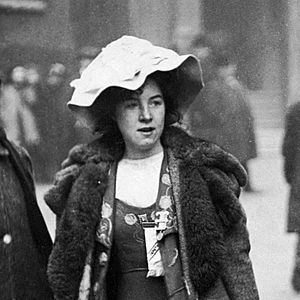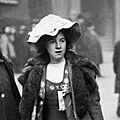Mabel Capper facts for kids
Quick facts for kids
Mabel Capper
|
|
|---|---|
 |
|
| Born | 23 June 1888 Chorlton-on-Medlock, Manchester, England
|
| Died | 1 September 1966 (aged 78) St Leonards-on-Sea, East Sussex, England
|
| Nationality | British |
| Organization | Women's Social and Political Union |
Mabel Henrietta Capper (born June 23, 1888 – died September 1, 1966) was a brave British suffragette. Suffragettes were women who fought for the right to vote. Mabel dedicated her time from 1907 to 1913 to the Women's Social and Political Union (WSPU). This group worked hard to get women the right to vote. Mabel was arrested six times for her activism. She also went on hunger strike and was one of the first suffragettes to be force-fed.
Contents
Early Life and Family
Mabel Capper was born in Manchester, England. Her mother, Elizabeth Jane Crews, was also a suffragette. Her father, William Bently Capper, was a chemist. He was also a leader in the Men's League for Women's Suffrage. This shows that both her parents supported women's right to vote. Mabel had a younger brother named William. The family later moved to Oxford Street in Manchester.
Fighting for Women's Vote
Mabel Capper joined the WSPU in 1907. She worked as an organizer for their Manchester group. In 1908, she moved to London. She lived at Clement's Inn, which was also the address for other important suffragette leaders.
Early Protests and Arrests
Mabel and another suffragette, Patricia Woodlock, acted as "human noticeboards." They walked around Liverpool advertising women's events. They also tried to enter the Royal Exchange in Manchester, which was only for men.
In October 1908, Mabel joined a protest at the House of Commons. She was with famous suffragettes like Christabel Pankhurst and Emmeline Pankhurst. Mabel was charged with blocking the way. She wore a special outfit in the WSPU colors. It had a sash that said "Votes for Women." She refused to pay a fine and spent one month in Holloway (HM Prison) prison.
Hunger Strikes and Force-Feeding
In July 1909, Mabel was arrested again. She was with Mary Leigh and Emily Davison at a meeting in Limehouse, London. They were charged with blocking the police. Mabel was sentenced to 21 days in prison. While in prison, Mabel went on a hunger strike. This meant she refused to eat. She was released after six days because of her hunger strike.
In August 1909, Mabel was in Birmingham with Mary Leigh. They were charged with causing a disturbance and breaking windows at a meeting. The Prime Minister, Herbert Asquith, was speaking there. Mabel was sent to Winson Green Prison. In September 1909, she went on hunger strike again. This time, she was force-fed. This was a very difficult and painful experience. The WSPU later gave Mabel a special "Hunger Strike Medal" for her bravery.
More Protests and Actions
In November 1909, Mabel was charged again in Birmingham. She was with Selina Martin and others. They were protesting at a meeting where Prime Minister Asquith was speaking. Police said Mabel stood on a statue of Queen Victoria and refused to come down.
In February 1910, Mabel, Dora Marsden, and Mary Gawthorpe accused three men of attacking them. The suffragettes said the men broke their flag and lifted Mabel. But the charges against the men were dismissed.
In November 1910, Mabel was arrested for breaking windows of a government building in London. The judge called her "quite a child." In March 1911, Mabel and Emily Davison wrote to a newspaper. They complained about how the police treated suffragettes. They said their complaints were ignored.
In November 1911, Mabel was imprisoned for breaking windows at a Post Office in Bath. This happened during a visit by David Lloyd George, another important politician.
In July 1912, Mabel was charged with other suffragettes in Dublin, Ireland. They were accused of planning to cause damage at a theater. The Prime Minister was speaking there. The charges against Mabel were later dropped.
Life During and After World War I
When World War I started in 1914, the suffragettes stopped their protests. Mabel joined the Volunteer Aid Detachment. This group helped during the war. Later, she became involved in movements that supported peace and socialism.
From 1919 to 1922, Mabel worked as a journalist for the Daily Herald newspaper. In 1921, she married a writer named Cecil Chisholm. They did not have any children.
Mabel Capper's Writings
Mabel Capper also used her writing to support women's rights. In 1908, she wrote to Manchester Guardian newspaper. She argued against the idea that women should not vote because they didn't serve in the military.
She wrote that when men go to war, women also help. They care for the injured and face dangers. She asked if their work was less important. This idea was later supported by the brave work of groups like the Women's Convoy Corps.
In October 1912, Mabel's play, The Betrothal of Number 13, was performed. It was about how being in prison could affect someone's life, even if they were innocent.
Mabel always cared about feminism and helping people who were struggling. In 1963, she wrote about her friend Mary Gawthorpe's father. She described what it was like to grow up in a working-class family in the 1880s. She noted how hard it was for people to find good jobs back then.
Mabel also reviewed Mary Gawthorpe's book, Up Hill to Holloway. She wrote about Mary's first speech in 1904. It was about providing food and clothing for poor children. Mabel explained how difficult it was in those days. Welfare depended on donations, and funds often ran out. She mentioned that meals for poor children cost very little, often just lentils.
Later Life and Legacy
Mabel Capper moved to Fairlight, near Hastings, in 1946. In her last ten years, she suffered from osteoarthritis. This made it hard for her to move, and she needed full-time care. She passed away in 1966. In 2018, a room in the Warrington Town Hall was named the Mabel Capper Room to honor her memory.
Images for kids
See also
 In Spanish: Mabel Capper para niños
In Spanish: Mabel Capper para niños



